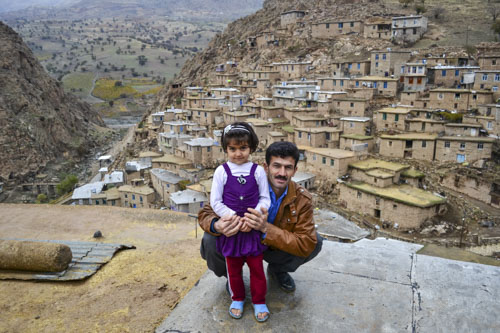Map showing Kurdish-inhabited areas of Armenia, Turkey, Syria, Iraq, and Iran.
By Rebecca Schmor
Kurdish is the language of one of the world’s largest ethnic groups without a nation state. With over 40 million Kurdish speakers, the region of Kurdistan in Western Asia spans modern-day Turkey, Iran, Iraq, Syria, and Armenia. The Kurdish language has two main written dialects: Kurmanji and Sorani. Sorani is recognized as an official language in Iraq, and Kurdish is a minority language in Armenia. However, the use of Kurdish in media and education has been banned over the years in Turkey and Syria. Despite having no official homeland and being subject to the language policies of different states, the Kurdish language has so far managed to resist extinction. These three successful efforts to preserve the language are helping to carry Kurdish into the next generations.
1. Folklore Collections
Kurdish language and culture have been passed down from generation to generation through proverbs, legends, fairy tales, epics, myths, agricultural teachings, prayers, poems, riddles, idioms, and songs. A 2023 study by Joanna Bocheńska and Farangis Ghaderi shows how Kurdish folklore collectors are helping to save the language from extinction, including the endangered Zazaki dialect.
By collecting Kurdish language folklore, activists have resisted assimilation policies and risked arrest to protect the rich vocabulary and important indigenous knowledge preserved in their oral traditions and dialects. Thanks to these efforts, Kurdish folklore collections, such as those by Ehmed Behrî and Oskar Mann, are available for future generations to learn about and continue preserving their linguistic and cultural heritage.

2. Parallel Corpora
Technology has universally transformed the way languages are used and accessed. The Kurdish language is no exception, and efforts to document and develop online Kurdish resources contribute to the vitality of the language. In 2022, a Kurdish language corpus was published by researchers Sina Ahmadi, Hossein Hassani, and Daban Jaff. The corpus includes over 12,000 parallel translations in the Kurmanji and Sorani dialects. It also provides over 2000 Kurdish–English translation pairs.
This publicly available Kurdish language corpus represents a significant effort to maintain and revitalize the Kurdish language. It helps to preserve the unique lexical and grammatical features of Kurdish dialects in digital form, paving the way for future developments in Kurdish machine translation.
3. University of Rojava
Despite its rich folklore and increasing online presence, the Kurdish language has been intentionally excluded from schooling in many countries. For a language to survive across generations, access to education in that language must be available. The University of Rojava, based in the de facto autonomous Kurdish region of northeastern Syria, embodies an effort to elevate the Kurdish language and culture by developing and mobilizing international Kurdish experts and scholars. One such scholar is Carleton University’s Jaffer Sheyholislami, who is working on The Oxford Handbook of Kurdish Linguistics.
The development of Kurdish studies programming at a higher education institute is an exceptional and promising linguistic preservation effort, reinforcing the legitimacy of the Kurdish language and strengthening its status. Known as the “University for the Kurds of Syria,” the University of Rojava is a model for the academic longevity of Kurdish.
Kurdish News: Intercomprehension Activity
Activity Description
In this genre-based intercomprehension activity, learners are invited to analyze a news website in Kurdish by reflecting on a series of questions and engaging in a class discussion. This activity is geared towards students studying a language for academic purposes but can be adapted for other contexts.
Activity Steps
- Go to the following website: https://www.kurdistan24.net/kmr
- With your classmates, discuss the following questions:
- What kind of website is this? How do you know?
- What words can you recognize on the first page?
- Based on the words and images under the tab “Aborî,” what do you think this word means?
- Can you find a story about Turkey?
- Can you find a story about soccer?
- Debrief as a class, reflecting on the following points:
- The combination of photos, headlines, and section tabs follows the format of a news website. The words “Radio” and “TV” in the top right corner also imply this is a type of media site.
- Most students should recognize the names of countries or people. Depending on their language repertoires, some students may be able to understand other lexical items. The class may also be able to identify word classes, such as nouns or verbs.
- “Aborî” means economy. Students may identify economic themes from photos of agriculture, infrastructure, or merchandise. Students may also guess “economy” as it is a common tab featured on news sites.
- To find a story about Turkey, students will need to navigate the “Nûçe” (news) tab and select the sub tab “Tirkiye.”
- To find a story about soccer, students will need to navigate the “Spor” (sports) tab and look for an article that has an image of a soccer match.
Activity Commentary
This activity encourages critical reflection on the role of multimodality and multiliteracies in meaning making, engaging learners in a task that requires them to interpret multiple textual modes including words, images, and other symbols. This kind of activity can promote a genre-based approach to pedagogy by highlighting the sociocultural purposes and variations of texts like news articles. It can also support the development of plurilingual intercomprehension skills or the ability to draw on knowledge of one language (e.g., English) to understand parts of another language (e.g., Kurdish). Inviting learners to engage in a genre-based intercomprehension activity can also reduce fear of unknown languages by encouraging learners to focus on their existing knowledge of linguistic structures. As such, this activity supports the development of partial competences while fostering metalinguistic awareness and promoting an openness to linguistic diversity.




